

A giant basket that uses condensation to gather drinking water. How do fireflies light up. Fireflies or lightning bugs make light within their bodies.
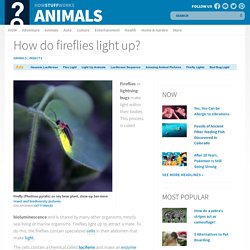
This process is called bioluminescence and is shared by many other organisms, mostly sea-living or marine organisms. Fireflies light up to attract a mate. To do this, the fireflies contain specialized cells in their abdomen that make light. The cells contain a chemical called luciferin and make an enzyme called luciferase. To make light, the luciferin combines with oxygen to form an inactive molecule called oxyluciferin.
The luciferin combines with adenosine triphosphate (ATP), which is found in all cells, to form luciferyl adenylate and pyrophosphate (PPi) on the surface of the luciferase enzyme. The wavelength of light given off is between 510 and 670 nanometers (pale yellow to reddish green color). The luciferin-luciferase chemical reaction has been used for years to measure the amount of ATP produced in cells and by various chemical reactions. Thoughts on Biomimicry » Biomimicry » Rhizome Blog » Biohabitats Inc. When faced with a design challenges, we ask a lot of questions.
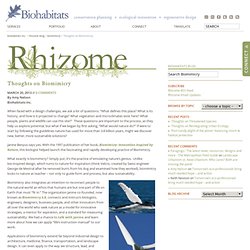
“What defines this place? What is its history, and how is it projected to change? What vegetation and microclimates exist here? What people, plants and wildlife can use this site?” These questions are important to the process, as they help us explore potential, but what if we began by first asking, “What would nature do?” To Tackle Runoff, Cities Turn to Green Initiatives by Dave Levitan. 24 Jan 2013: Report by dave levitan In Northeast Philadelphia, along busy Kensington Avenue, sits a small park.
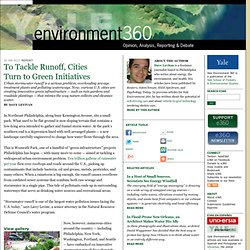
What used to be flat ground is now sloping terrain that contains a low-lying area intended to gather and funnel storm water. At the park’s southern end is a depression lined with well-arranged plants — a new landscape carefully engineered to change how water flows through the area. This is Womrath Park, one of a handful of “green infrastructure” projects Philadelphia has begun — with many more to come — aimed at tackling a widespread urban environment problem. “Stormwater runoff is one of the largest water pollution issues facing the U.S. today,” says Larry Levine, a senior attorney in the Natural Resource Defense Council’s water program.
View gallery Philadelphia Water Department. Nature Tech Magic Of Motion BBC Documentary 1 3. 5 Nature-Inspired Innovations. The shifting hues of squid skin, the stickiness of gecko toes, the self-cleansing of lotus leaves.
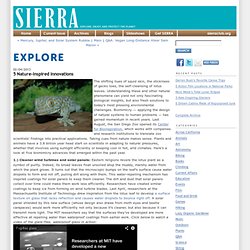
Understanding these and other natural phenomena can yield not only fascinating biological insights, but also fresh solutions to today’s most pressing environmental challenges. Biomimicry — applying the design of natural systems to human problems — has gained momentum in recent years. Last August, the San Diego Zoo opened its Center for Bioinspiration, which works with companies and research institutions to translate zoo scientists’ findings into practical applications. Taking cues from nature makes sense. Plants and animals have a 3.8 billion year head start on scientists in adapting to natural pressures, whether that involves using sunlight efficiently or keeping cool in hot, arid climates. 1.) 2.) 3.)
A firefly's light results from a chemical reaction that occurs in the cuticle, a part of the insect's protective outer covering. 4.) 5.) Bosco Verticale: The World's First Vertical Forest Nears Completion in Milan. Milan is one of the most polluted cities in the world, and the Bosco Verticale project aims to mitigate some of the environmental damage that has been inflicted upon the city by urbanization.
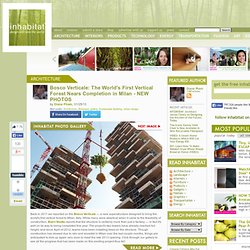
The design is made up of two high-density tower blocks with integrated photovoltaic energy systems and trees and vegetation planted on the facade. The plants help capture CO2 and dust in the air, reduce the need to mechanically heat and cool the tower’s apartments, and help mitigate the area’s urban heat island effect – particularly during the summer when temperatures can reach over 100 degrees. The two towers measure 260 feet and 367 feet tall respectively, and together they have the capacity to hold 480 big and medium size trees, 250 small size trees, 11,000 ground-cover plants and 5,000 shrubs (that’s the equivalent of 2.5 acres of forest). Biomimicry in Green Building: Nature in Sustainable Building Technologies. Biomimicry, the method of using concepts from nature to solve problems, is becoming a popular trend in green building and clean tech.

As stated by Janine Benyus in her 2002 book, Biomimicry: Innovation Inspired by Nature, “the Biomimicry Revolution introduces an era based not on what we can extract from nature, but what we can learn from her”. Thanks to evolution and survival of the fittest, nature is extremely efficient - organisms (possibly with the exception of humans) use minimal energy to perform functions essential to their livelihood.
Researchers are studying these strategies and copying them to produce more effective, energy efficient technologies for powering, heating, and cooling our buildings. 1. Termite Mounds and HVAC The Eastgate Center in Harare, Zimbabwe, a office center and shopping complex, was inspired by African termite mounds. 2. 3. Butterflies can fly in the rain because their wings have a 3D pattern that make them hydrophobic. Related Advice: